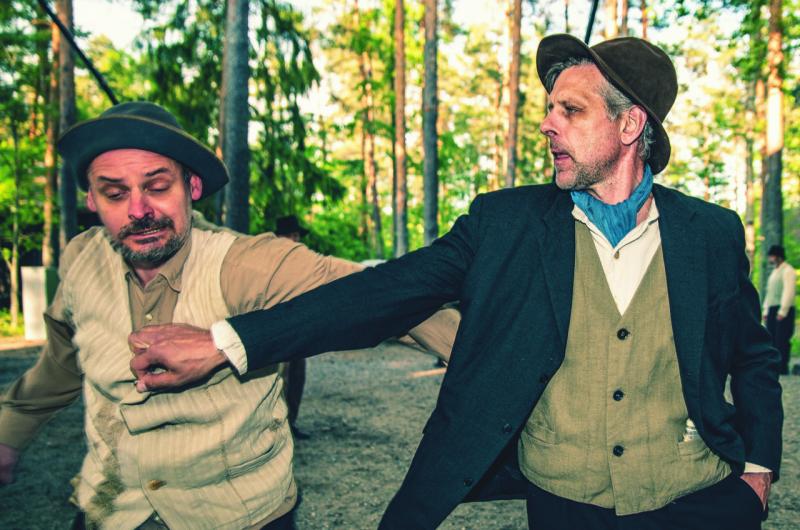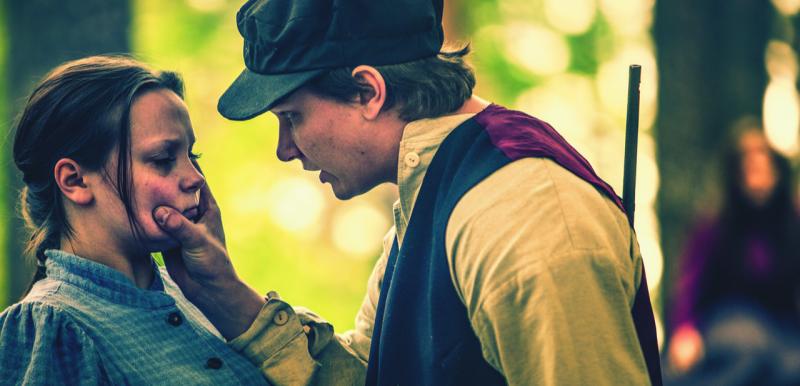Review: ROSVOT (ROBBERS) Echoes at Taabori and Stays Resonating in Your Mind and Emotions
ROSVOT (ROBBERS)
echoes at Taabori and stays resonating in your mind and emotions
In Finnish here

Mild Spoilers.
I sit at my place, quite front at the right hand side. I keenly wait for the show to start. The curiousity arises as early as a tiny movement is made behind the forest at the back of the stage area. The musicians walk to stage, to their places and the audience applauds already for their presence, as they start to tune their instruments. A small moment of silence and a giving of a rhythm and the music starts to bang at Taabori: the huge ensemble and all of the actors gather up in front of us, mouths from the biggest to the smallest ones opening up widely as they sing the Joutomiehiä Useless men -song.
Rosvot (Robbers) - a Ballad of Useless men premiered at Taabori, Nurmijärvi 26.6. The composer, director and scriptwriter of it is the multitalented Katriina Honkanen. Honkanen is behind the show's visuality too. She has designed the sets and costumes as well.
At Robbers we live the year 1820 at Nurmijärvi and the script is based on actual historical characters and the first organized criminal group in Finland. Mikko Södergård's (steady Timo Vesterinen) wife Mari Södergård (tear-jerking Tiina Alapaattikoski) is taken by the authorities to a forced labour at the far away factory because of the family's loaded up debt. The first, breathtaking scenic image is seen just before this: Mikko with his family stands in the middle of the ensemble that rapidly moves around them in a circle. The scenic image is formed within a vivid choreography and so as Mikko with his family finds their place and stands still, they are soon spotted from the midde of the hustle and bustle.
In the beginnin one can also spot great costumes that Marjaana Laajakoski has made out of Honkanen's design: Mikko's tielike scarf is blue, turquoise almost, whereas the one who lures Mikko to be a robber, Kustaa Ahlqvist (well speaking Tapio Takanen), has an orange tielike scarf. They are complimentary colors, which are nice to look at when these two men discuss intently how a poor man could stay alive, clearly differing at their world view in terms of moral.
What is this World, where poorness is a crime? Asks Mikko
In the script there are delicious, historical details, for example the pay packets (palkkapussit). Our men are thinking as they view the others at the pub who get drunk: how much of the pay packets even ends up to hungry family waiting at home or other virtous deeds anyways? It makes Mikko rethink the acts Ahlqvist suggests that he first thought immoral-- stealing.
Do you have to start as a robber to stay alive? Asks Mikko
Good question. The show makes you view fates of a fellow man and from them to reflect: what are the actual moral bases of the laws of the society, the social norms and the other accepted ways of behaving correctly in the eyes of general rules? Can you feed a starving child with a stolen bread? Is the worst sinner after all the one who doesn't give an extra cloth to the other who lacks of it -- for the Robbers' first organized theft starts from that.

The set design apart from the grand trees of Taabori is mobile. The background walls of a house, when needed, are formed from planks that are moved around. They're also used in dance choreos; symbolic stage violence and also just as a set design -- and it works! In this performance, even the walls have ears, which just adds up the curiosity in the audience, willingness to view this stealthy story. The ensemble is also delightfully benefitted from when they're cleverly used as a painting on the wall, wearing fancy wigs! Tiina Jokelainen has designed the hair and makeup.
Mikko Södergård decides to join Ahlqvist's idea and the following scenic storytelling is excellent: the ensemble of the Robbers-to-be are brought on stage. The main-scenes are performed in the middle of the stage, but the Robbers, varying in age, walk around, singing, pausing every time when the quick main scenes in the middle start. It looks very cool and works, because the Robbers who walk around join the main group little by little. The plot also goes on fast in this scene, so pay attention! Also, one will definitely get the more out of this the more he knows of the historic times and manners in the early 1800s, for it does have a lot of narrative details in the dialogue.
Keeping up with your loved one even though you're miles away; crossing the boundaries of your own morals in terms of surviving; straying to the bad ways; boys who vow to love but are found from whoever's arms... With a little switch of the topping the happenings in Robbers could have been transformed to our time and age, which seemingly hasn't changed from the 1800s. But even more it enchants in the old times, in the grand forests of Taabori, almost at the real places the acts we witness propably did happened.

Honkanen told in the interview that she didn't aim to direct a musical and I understand her decision. In any case, I strongly enjoyed how we exeptionally moved into one song with a guiding line "Mitä sinä kiusaat miestä? Kuulithan mitä hän sanoi", which is typical to musicals. Also, in many moments-- when some important lines were delivered or important acts were done-- I somehow awaited to hear small, perhaps a mere one instrument's background sounds to increase the tension and suspension. These moments where the ones that in other terms were very nicely thrilling: "Meistä voisi olla hyötyä toisillemme" where cornet Lindebaum (awesome Seppo Pirskanen) starts to lure Mikko to his plots, the first burglary, and also when there were the first conversations about the coming of the Cossacks. And in the end the Cossacks did arrive with their convincing costumes and all! I can't rememer when was the last time I'd seen such an impressive group scene, for the intensity was build up perfectly too. Thank you!
The costume designer Laajakoski's work are seen scene by scene: the lovers-to-be Adolf (sympathetic Santeri Kylmäniemi) and Ulriikka (virtuoso Anna-Sofia Luoma) has the same colour in their clothes, but Adolf has it just at the back of his vest, which to me carries meaning, which I won't spoil. Also the delirium costumes are excellent, which we see at the Stenvallin (sad yet adorable Erkki Herola) virsi Stenvall's psalm. The Beast's colors, of which they also sing about, peek from underneath the deliriums who dance wonderfully.
The scene itself begins-- as evil and suppressing thoughts do-- as if from nowhere, first with rapi invasions. The first delirium, Akseli Lehtinen jumps agilely on stage, making us exclaim in astonishment and surprise, as the next delirium Julius Lehtinen follows as bravely behind. The boys open up the taps and soon the stage is filled with dancing youths of Nurmijärvi's Dance Academy. Petri Kauppinen has directed all the dance choreos! Essi Haimi was the most distinctive to me throuough the show with her sorrowful eyes and looks, topped up with pro intensity.
The scene is finely ended so that these depressing thoughts first end up leaving the stage but in the end appear again and follow our senile Stenvall who walks off stage, mumbling about his internal horrors. And boy, isn't it good to see your own feelings manifested on stage. Ode to theatre!
Other character and actors I were especially fond of were the escapee duo Heikki Krig (intense and believable Kalle Annala) and Fabian "pastor" Berg (hilarious though scary Tapio Eronen). Annala had a distinctive Robber-habitus, presence and focus in his doings and Eronen had wonderful, quick-rhythmed laugh of a baddie. They had a good balance and worked wonderfully as a team, in terms of the story and acting too. One of the most fine moments in the show was when Berg's murder scarf ended up being a stola just by a little stroking and emphasizing of it. Anna-Stiina Vacker (touching Viivi Rättyä) is one of the most realistic, well written and accessable character on an emotional level. Her song did deserve the applaud.

Once more I'd bring up the ensemble, whose joy overflowed beautifully at the Pois Kaikki Pirun Tieltä Get away of the Devil -song and dance scene before the intermission. The ensemble is the total base of the show; its placing all around the near surroundings, especially in the large marketpalce scenes, gives us deep illusion that we're actually peeking into the 200-year-old happenings. The same illusion arises when the Robbers guard Taabori with their guns at the sides of the audience, the rest of them executing the robbings at the centre stgage.
It is obvious that the director has had a clear vision from the start. At times I forgot I was watching a show by performers that do this just as a hobby: Kehruuhuoneen naiset ja tytöt The women and girls of the spinning factor -made my eyes wet and the letter cacophony scene with the end's whisper is one of the best moments of the performance. The red ropes and the choreography with them, which we saw in the trailer too, impresses. The same colorscheme is continued in the delirium costumes as well as in the axes of plunder, with which a cut is made to a pitiful hand. Nifty effects on point!
There was one thing I found a little displeasing: the breaking of the fourth wall-- in the Kehruuhuone Spinning factory scene where the dancers leaned really close to the audience-- I think it happened in a little too distressing moment. It was a cool effect, yes, yet it doesn't pull you to their side emotionally, but withdraws you from them. Perhaps it was the meaning of it, to make us look at them like the rest of the world did during those times, but in terms of a flowing storytelling perhaps it would have worked better if the fourth wall would have been broken a little earlier. For example in the scene where Maria Mähkä (giggly Minna Engström) sings of her beauty in the Veri Väkevä Strong blood - song; she could have moved more around the sandy area and also come near the audience. This way the spinning factory's audience contact wouldn't have been so disengageing in terms of charactergroup-attachment, though it was a small moment.
Finally, something I have to top my hat to especially to is how Robbers doesn't gush about with too much themes or attempted ones in it, which is common in nowadays theatre; especially the themes you usually find merely written in the program but not performed distinctively enough on stage. So, Robbers play with just right amount of cards in their hands: they have reoccurring scenes that rhythm the whole ongoing story, like the reading of the letters Mikko gets from her wife. Themes like love, despair and dreams are plainly seen so that one can clearly follow them from the beginning to the very end.
All in all Robbers is the Summer's 2019 theatre- and music case, full of talented and keen doers. You definitely should go and experience it!
Article: Rosanna Liuski
Photos: Marko Nurmi
See the trailer of the show, which you can also watch!

The show Rosvot (Robbers) is currently on a hold, but will continue on 14.8.
More info and tickets through this link
Reader Reviews

Videos

